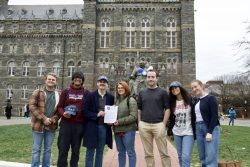Last week, the Latin@ Leadership Forum sent out a survey to Georgetown students to ask for support for its efforts to create a Casa Latina through an online survey. The house, modeled after the Center for Multicultural Equity and Access’ Black House, will dedicate a safe space for students and alumni who identify as Latino and for their allies. The Georgetown community should support the creation of a Casa Latina, because it will serve as an extension to Georgetown’s commitment to social justice.
In the past, Georgetown has been unafraid to tackle injustices and oppression that Latinos face in the United States and on the Hilltop. The school has regularly invited high-profile advocates for the Latino community, including Senator Dick Durbin (SFS ’66), who came to Gaston Hall in Oct. 2013 to speak about undocumented youth—a group made up largely of Latin Americans. President DeGioia was vocal in his support of Durbin’s DREAM Act when it made its way through Congress in 2010. At Epicurean and Aramark’s dining outlets, students have supported campaigns that have shielded immigrant workers from employer abuse and wage theft. Through organizations such as the Kalmanovitz Initiative for Labor and the Working Poor, students help laborers, mostly those of Latino descent, in D.C. with their rights and access to District government services.
A Casa Latina, in addition to being a hub for spreading knowledge about Latino culture to campus, will serve to amplify the valuable social justice work that students have been doing to support the Latino community. It will also continue the university’s commendable track record of supporting the Latino population and the issues they face in the United States.
The Black House has a powerful presence on campus. It spearheads programming, promotes critical conversations about diversity, and supports all Georgetown students of color during critical periods in race relations in the nation and on campus. Yet, members of Black House have recognized as early as 2012 that the house’s name might be limiting its mission to serve all communities of color. Indeed, all communities should be able to access their own dedicated spaces, where their peers, rather than a consolidated institutional entity, can best cater to their interests. If the university is cognizant of the value students see in keeping the LGTBQ Resource Center, the Women’s Center, and CMEA separate after it began discussions on plans to combine the three centers last semester, then it should also recognize the value of a Casa Latina next to the Black House.
Granted, Hoyas who identify as Latino and their allies come from a plethora of backgrounds. If Latin@ Leadership Forum’s proposal comes to fruition, a Casa Latina will arrive with broad goals, unable to represent all of the individual identities of all its members. Nonetheless, the creation of a Casa Latina will be an encouraging step forward for the campus to promote diversity and a comprehensive understanding for others.




